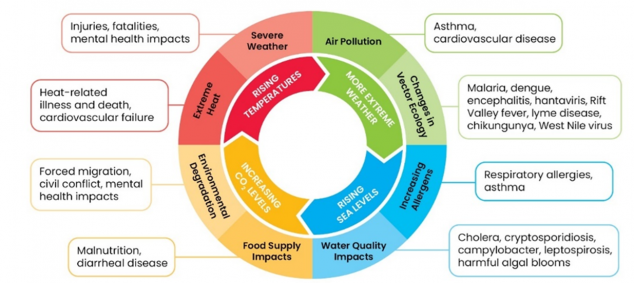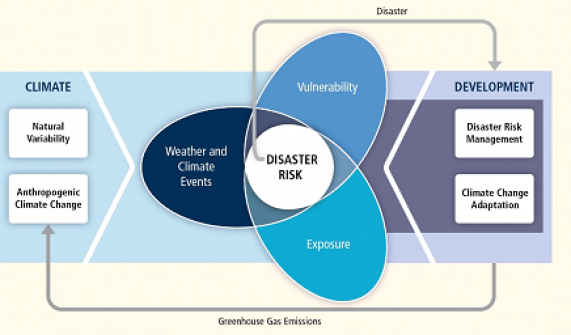How climate change will impact health
This section explains the ways that climate change will potentially affect the health and wellbeing of New Zealanders.
On this page:
A wide range of climate change impacts on health and wellbeing
Climate change has been described as “the biggest global health threat in the 21st century” [1]. Climate change may affect health and wellbeing through [2,3]:
- direct impacts: caused by climate-related hazards like floods, wildfires, heatwaves, and sea-level rise
- indirect impacts related to the environment: caused by worsening air quality or water quality, vector-borne diseases and other environmental consequences of the changing climate
- other indirect impacts: mental health impacts and health inequities.
The Ministry of Health's Health National Adaptation Plan summarises the health impacts of climate change (Figure 1).
Figure 1: Impacts of climate change on human health

Source: Ministry of Health (2024) [4], adapted from the Centre for Disease Control and Prevention
Health risks from climate change depend on three factors: hazards (such as weather and climate events), exposure to those hazards, and vulnerability (Figure 2) [5]. Where these three factors intersect is where the greatest risk to human health and wellbeing is.
Figure 2: IPCC framework for risk, exposure, vulnerability and hazards

Source: IPCC 2012 [6]
Health impacts from climate-related hazards
Climate-related hazards include extreme weather events, floods, heatwaves, wildfires, drought, sea level rise and coastal inundation [2].
The following table presents direct impacts from climate-related hazards in New Zealand, and examples of the health impacts of these hazards.
| Climate-related hazards | Exposure | Example of health impacts |
| Flooding and extreme weather events (intense storms, heavy rainfall, high winds) |
Flooding Heavy rainfall Wind damage to trees, properties
|
Drowning Injury Property damage Mental health Gastrointestinal diseases (eg giardiasis, cryptosporidiosis, salmonellosis) Leptospirosis from contaminated floodwaters Living in damp housing conditions, which can lead to respiratory impacts Impact on agriculture Damage to key infrastructure (roading, communications, power and gas supplies, water supplies, wastewater systems etc) Disruptions to health care services |
| Extreme heat and heatwaves |
Heatwaves Higher temperatures Increasing number of hot days Decreasing number of cold days |
Heat exhaustion Heat stroke Mortality Reduced time outdoors (eg exercising, working, commuting) and/or greater use of vehicles Increased risk of food safety issues, eg salmonellosis Reduced mortality due to cold |
| Drought |
Extended periods with lack of rain Soil moisture deficit |
Agricultural and primary industry impacts Mental health impacts (particularly in rural areas and for people working in primary industries) Water quality Water scarcity Wildfire risk |
| Fire danger | Wildfires |
Deaths Damage to property, housing Damage to infrastructure Air pollution from smoke affecting respiratory and cardiovascular health |
| Sea level rise and coastal inundation | Sea-level rise, erosion, displacement |
Coastal flooding Damage to property, housing, belongings Damage to key infrastructure (eg transportation, communication, water supplies, power and gas supplies) Displacement Loss of livelihoods Loss of food security Mental health impacts |
Indirect impacts through environmental health
Climate change may also indirectly impact health and wellbeing, through impacts on the environment [2]. The following table presents some of the indirect impacts from climate-related hazards in New Zealand, and examples of the health impacts of these hazards.
| Topic | Link with climate change | Health impact |
| Air quality |
Drought conditions can increase dust and particulate matter (eg PM10) Wildfires can lead to increased particulate matter Heatwaves and lack of wind can increase air pollution levels Note: Changing from petrol/diesel vehicles to electric vehicles (EVs) would improve air quality |
Cardiovascular disease Respiratory impacts Premature mortality
|
| Water quality and availability |
Drought and low water levels can impact the quality and quantity of drinking water, particularly for populations relying on rainwater tanks [7] Drought and low water levels can increase the concentration of Cryptosporidium cysts in waterways, which heavy rainfall can then flush out [8] Higher temperatures can increase the risk of salmonellosis from food safety issues [9] |
Waterborne diseases (giardiasis, cryptosporidiosis, campylobacteriosis) Foodborne diseases (salmonellosis) |
| Vector-borne disease | Increased risk of mosquito-borne diseases, if certain species of mosquitoes are established in NZ |
Mosquito-borne diseases (eg malaria, dengue fever, Ross River fever) Other vector-borne diseases (eg from ticks), eg Lyme disease |
| Pollens and allergens |
Wind can increase pollen dispersal Climate change and higher temperatures may increase the amount and allergic potential of pollen [2] |
Hayfever Allergic reactions, such as wheeze/asthma |
| UV exposure | Increased temperatures may increase UV exposure, which may in turn increase the risk of skin cancer if sun protection is not used [10, 11] |
Melanoma Non-melanoma skin cancer |
Other indirect (or diffuse) impacts: People's health may also be affected if they need to substantially change their lives due to climate change and/or related social and economic changes [2]. Examples include:
- Mental health and wellbeing: impacts on mental health, due to displacement due to sea level rise, damage to property through flooding, loss of livelihood.
- Health inequities and socioeconomic deprivation: unequal and unfair impacts due to climate change and/or related social or economic changes. Climate change is likely to most affect vulnerable populations and may increase existing disparities.
Social vulnerability to climate-related hazards
People who have higher levels of social vulnerability have a higher risk of experiencing negative impacts from climate-related hazards. Vulnerable population groups may be less able to prepare for, cope with or adapt to a hazard.
People can be more vulnerable due to:
- being more susceptible to health impacts (for example, due to being young, old, or having a chronic health condition or disability)
- lack of resilience (capacity to prepare, cope and recover) relating to the following aspects: having enough money to cope with losses; social connectedness; awareness and skills to face hazards; safe, secure and healthy housing; enough food and water to cope with shortage; decision-making and participation
Measuring population vulnerability through a set of indicators provides valuable information to inform planning and decision-making.
For more information, see New Zealand's first suite of social vulnerability indicators, developed by EHINZ.
Adaptation to climate-related hazards
Climate change adaptation is important to reduce the risk of negative impacts of climate-related hazards in the future. Adaptation includes transforming existing systems, and can also include disaster risk management, early warning systems, and climate services. The Ministry of Health has released a Health National Adaptation Plan [4].
A key part of adaptation to climate change includes reducing vulnerability, including the vulnerability of the population [12].
Adaptation activities can include:
- Hazard intervention (ie actions to reduce hazards)
- Exposure reduction (ie reducing people’s exposure to hazards)
- Susceptibility reduction (ie reducing susceptibility, such as by improving population health and wellbeing)
- Resilience improvement (eg improving people’s capacity to anticipate, prepare for, cope with and recover from hazards).
The lower the exposure to hazards, and the healthier and more resilient our population, the lower the risk of negative impacts from climate-related hazards.
Monitoring measures of susceptibility and resilience through indicators can show changes in vulnerability over time, and inform adaptation activities. See our work on climate change, including monitoring climate-related hazards, health outcomes, and social vulnerability.
